Corporate Governance and Fraud: Legal vs. Ethical Compliance Report
VerifiedAdded on 2023/03/23
|6
|2661
|91
Report
AI Summary
This report examines the critical aspects of corporate governance, differentiating between legal and ethical compliance within an organizational context. It begins with an introduction to corporate governance, emphasizing its role in establishing rules, policies, and laws that govern a company's operations and stakeholder relationships. The report highlights the significance of corporate governance in ensuring fairness, responsibility, transparency, and accountability, which are essential for maintaining discipline and achieving organizational objectives. It then presents a detailed rebuttal, arguing the importance of both legal and ethical governance. The legal aspect provides a structural framework, ensuring adherence to rules and regulations, while the ethical aspect fosters responsible behavior among employees and addresses the company's social responsibilities. The report concludes by reiterating the need for a balanced approach, integrating both legal and ethical considerations for effective corporate governance. It stresses the importance of ethical standards in attracting investors, maintaining a positive public image, and ensuring long-term sustainability. The report also discusses the role of ethical governance in areas such as advertising, supplier relationships, and the responsibilities of the board of directors. The assignment includes an analysis of the application of ethical theories and decision-making models, with the aim of arriving at responsible and ethical judgments in group contexts, as required for the MAA763 Governance and Fraud course.

Contents
Introduction......................................................................................................................................2
Rebuttal............................................................................................................................................3
Conclusion.......................................................................................................................................5
References........................................................................................................................................5
Introduction......................................................................................................................................2
Rebuttal............................................................................................................................................3
Conclusion.......................................................................................................................................5
References........................................................................................................................................5
Paraphrase This Document
Need a fresh take? Get an instant paraphrase of this document with our AI Paraphraser
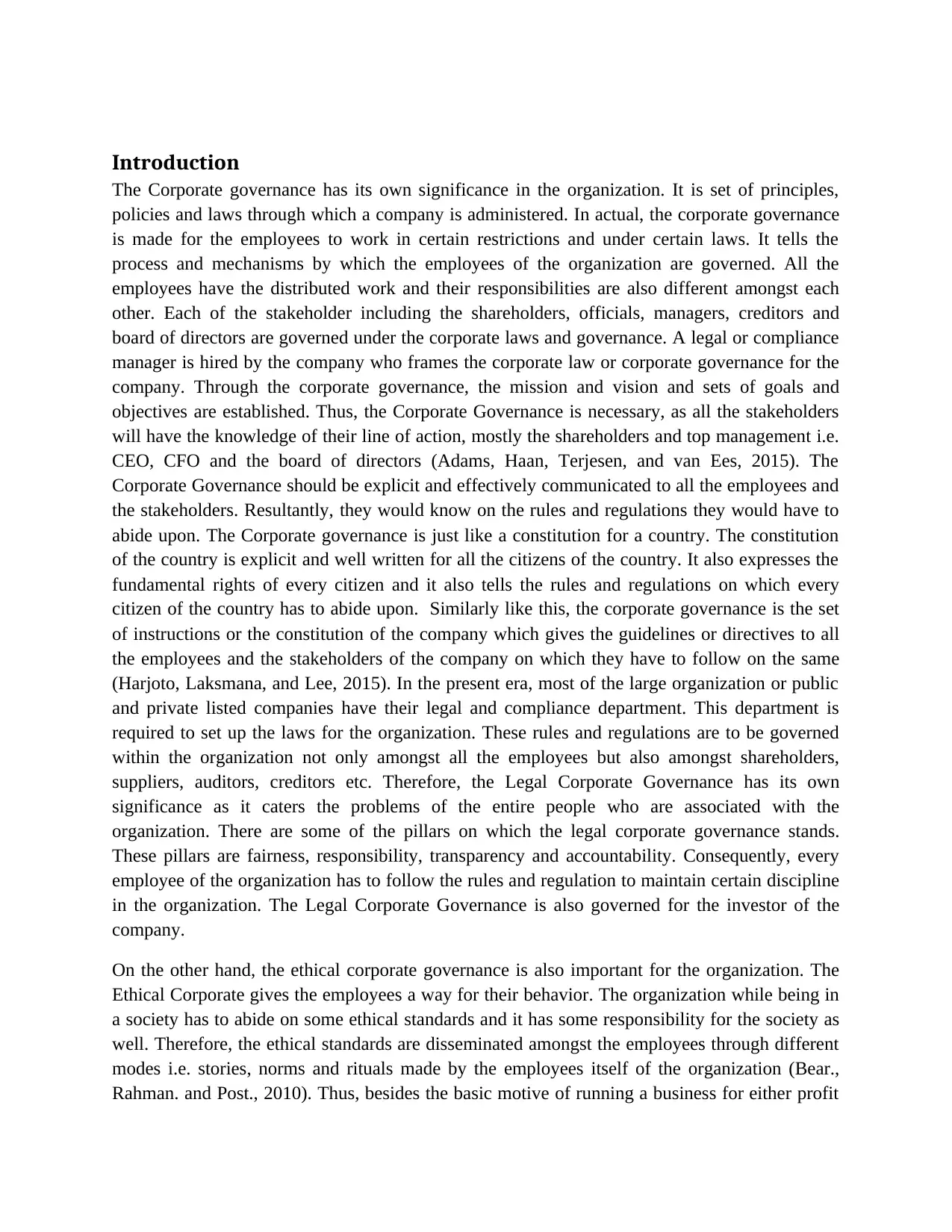
Introduction
The Corporate governance has its own significance in the organization. It is set of principles,
policies and laws through which a company is administered. In actual, the corporate governance
is made for the employees to work in certain restrictions and under certain laws. It tells the
process and mechanisms by which the employees of the organization are governed. All the
employees have the distributed work and their responsibilities are also different amongst each
other. Each of the stakeholder including the shareholders, officials, managers, creditors and
board of directors are governed under the corporate laws and governance. A legal or compliance
manager is hired by the company who frames the corporate law or corporate governance for the
company. Through the corporate governance, the mission and vision and sets of goals and
objectives are established. Thus, the Corporate Governance is necessary, as all the stakeholders
will have the knowledge of their line of action, mostly the shareholders and top management i.e.
CEO, CFO and the board of directors (Adams, Haan, Terjesen, and van Ees, 2015). The
Corporate Governance should be explicit and effectively communicated to all the employees and
the stakeholders. Resultantly, they would know on the rules and regulations they would have to
abide upon. The Corporate governance is just like a constitution for a country. The constitution
of the country is explicit and well written for all the citizens of the country. It also expresses the
fundamental rights of every citizen and it also tells the rules and regulations on which every
citizen of the country has to abide upon. Similarly like this, the corporate governance is the set
of instructions or the constitution of the company which gives the guidelines or directives to all
the employees and the stakeholders of the company on which they have to follow on the same
(Harjoto, Laksmana, and Lee, 2015). In the present era, most of the large organization or public
and private listed companies have their legal and compliance department. This department is
required to set up the laws for the organization. These rules and regulations are to be governed
within the organization not only amongst all the employees but also amongst shareholders,
suppliers, auditors, creditors etc. Therefore, the Legal Corporate Governance has its own
significance as it caters the problems of the entire people who are associated with the
organization. There are some of the pillars on which the legal corporate governance stands.
These pillars are fairness, responsibility, transparency and accountability. Consequently, every
employee of the organization has to follow the rules and regulation to maintain certain discipline
in the organization. The Legal Corporate Governance is also governed for the investor of the
company.
On the other hand, the ethical corporate governance is also important for the organization. The
Ethical Corporate gives the employees a way for their behavior. The organization while being in
a society has to abide on some ethical standards and it has some responsibility for the society as
well. Therefore, the ethical standards are disseminated amongst the employees through different
modes i.e. stories, norms and rituals made by the employees itself of the organization (Bear.,
Rahman. and Post., 2010). Thus, besides the basic motive of running a business for either profit
The Corporate governance has its own significance in the organization. It is set of principles,
policies and laws through which a company is administered. In actual, the corporate governance
is made for the employees to work in certain restrictions and under certain laws. It tells the
process and mechanisms by which the employees of the organization are governed. All the
employees have the distributed work and their responsibilities are also different amongst each
other. Each of the stakeholder including the shareholders, officials, managers, creditors and
board of directors are governed under the corporate laws and governance. A legal or compliance
manager is hired by the company who frames the corporate law or corporate governance for the
company. Through the corporate governance, the mission and vision and sets of goals and
objectives are established. Thus, the Corporate Governance is necessary, as all the stakeholders
will have the knowledge of their line of action, mostly the shareholders and top management i.e.
CEO, CFO and the board of directors (Adams, Haan, Terjesen, and van Ees, 2015). The
Corporate Governance should be explicit and effectively communicated to all the employees and
the stakeholders. Resultantly, they would know on the rules and regulations they would have to
abide upon. The Corporate governance is just like a constitution for a country. The constitution
of the country is explicit and well written for all the citizens of the country. It also expresses the
fundamental rights of every citizen and it also tells the rules and regulations on which every
citizen of the country has to abide upon. Similarly like this, the corporate governance is the set
of instructions or the constitution of the company which gives the guidelines or directives to all
the employees and the stakeholders of the company on which they have to follow on the same
(Harjoto, Laksmana, and Lee, 2015). In the present era, most of the large organization or public
and private listed companies have their legal and compliance department. This department is
required to set up the laws for the organization. These rules and regulations are to be governed
within the organization not only amongst all the employees but also amongst shareholders,
suppliers, auditors, creditors etc. Therefore, the Legal Corporate Governance has its own
significance as it caters the problems of the entire people who are associated with the
organization. There are some of the pillars on which the legal corporate governance stands.
These pillars are fairness, responsibility, transparency and accountability. Consequently, every
employee of the organization has to follow the rules and regulation to maintain certain discipline
in the organization. The Legal Corporate Governance is also governed for the investor of the
company.
On the other hand, the ethical corporate governance is also important for the organization. The
Ethical Corporate gives the employees a way for their behavior. The organization while being in
a society has to abide on some ethical standards and it has some responsibility for the society as
well. Therefore, the ethical standards are disseminated amongst the employees through different
modes i.e. stories, norms and rituals made by the employees itself of the organization (Bear.,
Rahman. and Post., 2010). Thus, besides the basic motive of running a business for either profit
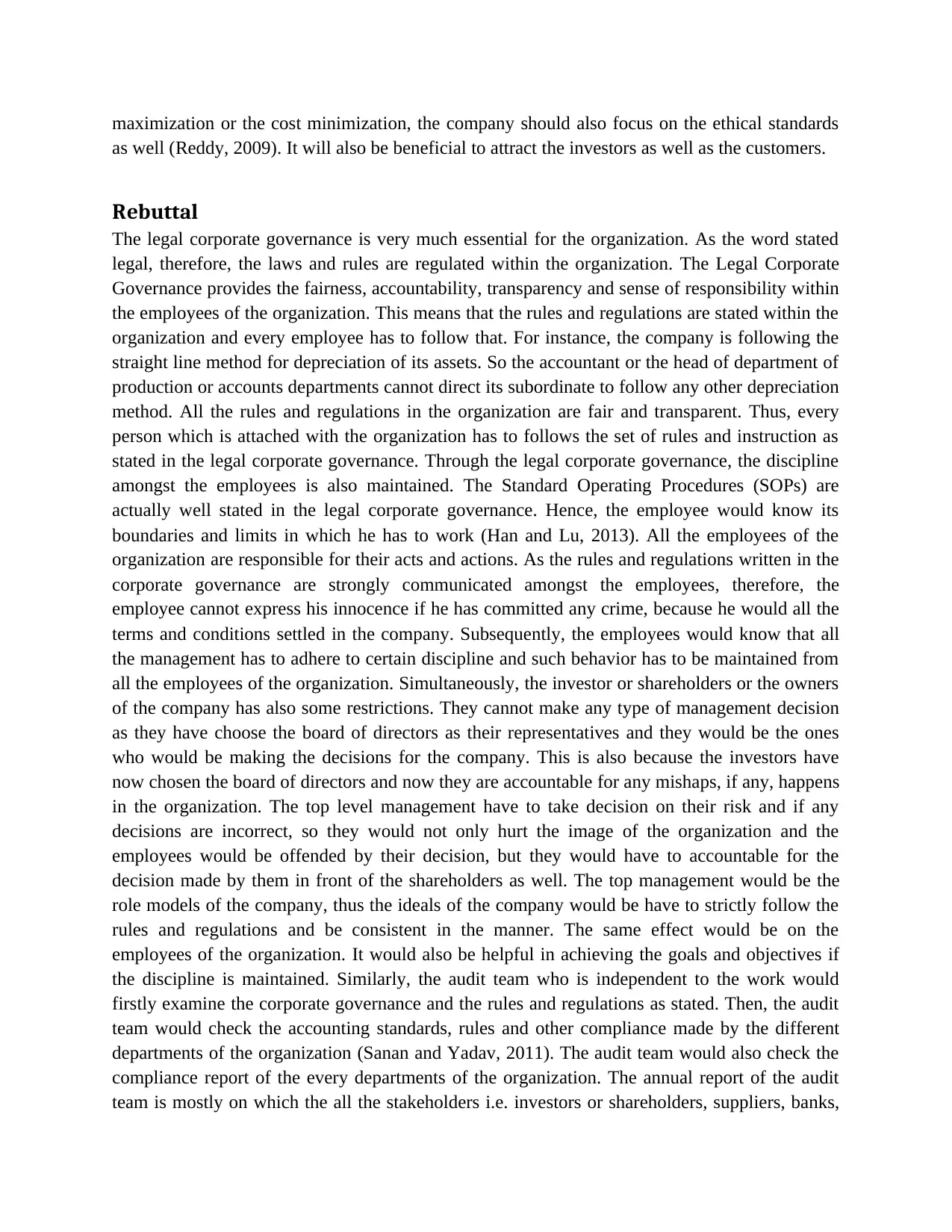
maximization or the cost minimization, the company should also focus on the ethical standards
as well (Reddy, 2009). It will also be beneficial to attract the investors as well as the customers.
Rebuttal
The legal corporate governance is very much essential for the organization. As the word stated
legal, therefore, the laws and rules are regulated within the organization. The Legal Corporate
Governance provides the fairness, accountability, transparency and sense of responsibility within
the employees of the organization. This means that the rules and regulations are stated within the
organization and every employee has to follow that. For instance, the company is following the
straight line method for depreciation of its assets. So the accountant or the head of department of
production or accounts departments cannot direct its subordinate to follow any other depreciation
method. All the rules and regulations in the organization are fair and transparent. Thus, every
person which is attached with the organization has to follows the set of rules and instruction as
stated in the legal corporate governance. Through the legal corporate governance, the discipline
amongst the employees is also maintained. The Standard Operating Procedures (SOPs) are
actually well stated in the legal corporate governance. Hence, the employee would know its
boundaries and limits in which he has to work (Han and Lu, 2013). All the employees of the
organization are responsible for their acts and actions. As the rules and regulations written in the
corporate governance are strongly communicated amongst the employees, therefore, the
employee cannot express his innocence if he has committed any crime, because he would all the
terms and conditions settled in the company. Subsequently, the employees would know that all
the management has to adhere to certain discipline and such behavior has to be maintained from
all the employees of the organization. Simultaneously, the investor or shareholders or the owners
of the company has also some restrictions. They cannot make any type of management decision
as they have choose the board of directors as their representatives and they would be the ones
who would be making the decisions for the company. This is also because the investors have
now chosen the board of directors and now they are accountable for any mishaps, if any, happens
in the organization. The top level management have to take decision on their risk and if any
decisions are incorrect, so they would not only hurt the image of the organization and the
employees would be offended by their decision, but they would have to accountable for the
decision made by them in front of the shareholders as well. The top management would be the
role models of the company, thus the ideals of the company would be have to strictly follow the
rules and regulations and be consistent in the manner. The same effect would be on the
employees of the organization. It would also be helpful in achieving the goals and objectives if
the discipline is maintained. Similarly, the audit team who is independent to the work would
firstly examine the corporate governance and the rules and regulations as stated. Then, the audit
team would check the accounting standards, rules and other compliance made by the different
departments of the organization (Sanan and Yadav, 2011). The audit team would also check the
compliance report of the every departments of the organization. The annual report of the audit
team is mostly on which the all the stakeholders i.e. investors or shareholders, suppliers, banks,
as well (Reddy, 2009). It will also be beneficial to attract the investors as well as the customers.
Rebuttal
The legal corporate governance is very much essential for the organization. As the word stated
legal, therefore, the laws and rules are regulated within the organization. The Legal Corporate
Governance provides the fairness, accountability, transparency and sense of responsibility within
the employees of the organization. This means that the rules and regulations are stated within the
organization and every employee has to follow that. For instance, the company is following the
straight line method for depreciation of its assets. So the accountant or the head of department of
production or accounts departments cannot direct its subordinate to follow any other depreciation
method. All the rules and regulations in the organization are fair and transparent. Thus, every
person which is attached with the organization has to follows the set of rules and instruction as
stated in the legal corporate governance. Through the legal corporate governance, the discipline
amongst the employees is also maintained. The Standard Operating Procedures (SOPs) are
actually well stated in the legal corporate governance. Hence, the employee would know its
boundaries and limits in which he has to work (Han and Lu, 2013). All the employees of the
organization are responsible for their acts and actions. As the rules and regulations written in the
corporate governance are strongly communicated amongst the employees, therefore, the
employee cannot express his innocence if he has committed any crime, because he would all the
terms and conditions settled in the company. Subsequently, the employees would know that all
the management has to adhere to certain discipline and such behavior has to be maintained from
all the employees of the organization. Simultaneously, the investor or shareholders or the owners
of the company has also some restrictions. They cannot make any type of management decision
as they have choose the board of directors as their representatives and they would be the ones
who would be making the decisions for the company. This is also because the investors have
now chosen the board of directors and now they are accountable for any mishaps, if any, happens
in the organization. The top level management have to take decision on their risk and if any
decisions are incorrect, so they would not only hurt the image of the organization and the
employees would be offended by their decision, but they would have to accountable for the
decision made by them in front of the shareholders as well. The top management would be the
role models of the company, thus the ideals of the company would be have to strictly follow the
rules and regulations and be consistent in the manner. The same effect would be on the
employees of the organization. It would also be helpful in achieving the goals and objectives if
the discipline is maintained. Similarly, the audit team who is independent to the work would
firstly examine the corporate governance and the rules and regulations as stated. Then, the audit
team would check the accounting standards, rules and other compliance made by the different
departments of the organization (Sanan and Yadav, 2011). The audit team would also check the
compliance report of the every departments of the organization. The annual report of the audit
team is mostly on which the all the stakeholders i.e. investors or shareholders, suppliers, banks,
⊘ This is a preview!⊘
Do you want full access?
Subscribe today to unlock all pages.

Trusted by 1+ million students worldwide
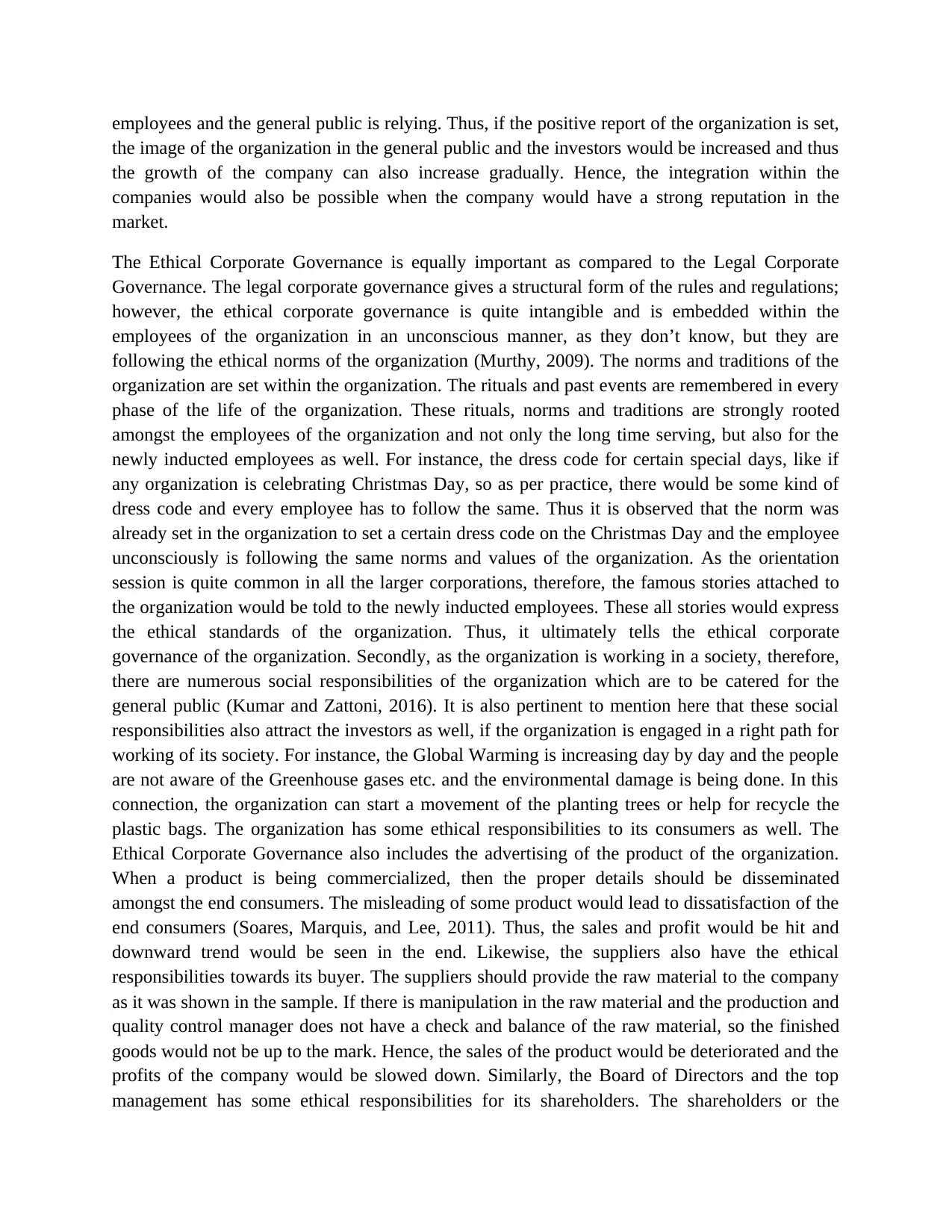
employees and the general public is relying. Thus, if the positive report of the organization is set,
the image of the organization in the general public and the investors would be increased and thus
the growth of the company can also increase gradually. Hence, the integration within the
companies would also be possible when the company would have a strong reputation in the
market.
The Ethical Corporate Governance is equally important as compared to the Legal Corporate
Governance. The legal corporate governance gives a structural form of the rules and regulations;
however, the ethical corporate governance is quite intangible and is embedded within the
employees of the organization in an unconscious manner, as they don’t know, but they are
following the ethical norms of the organization (Murthy, 2009). The norms and traditions of the
organization are set within the organization. The rituals and past events are remembered in every
phase of the life of the organization. These rituals, norms and traditions are strongly rooted
amongst the employees of the organization and not only the long time serving, but also for the
newly inducted employees as well. For instance, the dress code for certain special days, like if
any organization is celebrating Christmas Day, so as per practice, there would be some kind of
dress code and every employee has to follow the same. Thus it is observed that the norm was
already set in the organization to set a certain dress code on the Christmas Day and the employee
unconsciously is following the same norms and values of the organization. As the orientation
session is quite common in all the larger corporations, therefore, the famous stories attached to
the organization would be told to the newly inducted employees. These all stories would express
the ethical standards of the organization. Thus, it ultimately tells the ethical corporate
governance of the organization. Secondly, as the organization is working in a society, therefore,
there are numerous social responsibilities of the organization which are to be catered for the
general public (Kumar and Zattoni, 2016). It is also pertinent to mention here that these social
responsibilities also attract the investors as well, if the organization is engaged in a right path for
working of its society. For instance, the Global Warming is increasing day by day and the people
are not aware of the Greenhouse gases etc. and the environmental damage is being done. In this
connection, the organization can start a movement of the planting trees or help for recycle the
plastic bags. The organization has some ethical responsibilities to its consumers as well. The
Ethical Corporate Governance also includes the advertising of the product of the organization.
When a product is being commercialized, then the proper details should be disseminated
amongst the end consumers. The misleading of some product would lead to dissatisfaction of the
end consumers (Soares, Marquis, and Lee, 2011). Thus, the sales and profit would be hit and
downward trend would be seen in the end. Likewise, the suppliers also have the ethical
responsibilities towards its buyer. The suppliers should provide the raw material to the company
as it was shown in the sample. If there is manipulation in the raw material and the production and
quality control manager does not have a check and balance of the raw material, so the finished
goods would not be up to the mark. Hence, the sales of the product would be deteriorated and the
profits of the company would be slowed down. Similarly, the Board of Directors and the top
management has some ethical responsibilities for its shareholders. The shareholders or the
the image of the organization in the general public and the investors would be increased and thus
the growth of the company can also increase gradually. Hence, the integration within the
companies would also be possible when the company would have a strong reputation in the
market.
The Ethical Corporate Governance is equally important as compared to the Legal Corporate
Governance. The legal corporate governance gives a structural form of the rules and regulations;
however, the ethical corporate governance is quite intangible and is embedded within the
employees of the organization in an unconscious manner, as they don’t know, but they are
following the ethical norms of the organization (Murthy, 2009). The norms and traditions of the
organization are set within the organization. The rituals and past events are remembered in every
phase of the life of the organization. These rituals, norms and traditions are strongly rooted
amongst the employees of the organization and not only the long time serving, but also for the
newly inducted employees as well. For instance, the dress code for certain special days, like if
any organization is celebrating Christmas Day, so as per practice, there would be some kind of
dress code and every employee has to follow the same. Thus it is observed that the norm was
already set in the organization to set a certain dress code on the Christmas Day and the employee
unconsciously is following the same norms and values of the organization. As the orientation
session is quite common in all the larger corporations, therefore, the famous stories attached to
the organization would be told to the newly inducted employees. These all stories would express
the ethical standards of the organization. Thus, it ultimately tells the ethical corporate
governance of the organization. Secondly, as the organization is working in a society, therefore,
there are numerous social responsibilities of the organization which are to be catered for the
general public (Kumar and Zattoni, 2016). It is also pertinent to mention here that these social
responsibilities also attract the investors as well, if the organization is engaged in a right path for
working of its society. For instance, the Global Warming is increasing day by day and the people
are not aware of the Greenhouse gases etc. and the environmental damage is being done. In this
connection, the organization can start a movement of the planting trees or help for recycle the
plastic bags. The organization has some ethical responsibilities to its consumers as well. The
Ethical Corporate Governance also includes the advertising of the product of the organization.
When a product is being commercialized, then the proper details should be disseminated
amongst the end consumers. The misleading of some product would lead to dissatisfaction of the
end consumers (Soares, Marquis, and Lee, 2011). Thus, the sales and profit would be hit and
downward trend would be seen in the end. Likewise, the suppliers also have the ethical
responsibilities towards its buyer. The suppliers should provide the raw material to the company
as it was shown in the sample. If there is manipulation in the raw material and the production and
quality control manager does not have a check and balance of the raw material, so the finished
goods would not be up to the mark. Hence, the sales of the product would be deteriorated and the
profits of the company would be slowed down. Similarly, the Board of Directors and the top
management has some ethical responsibilities for its shareholders. The shareholders or the
Paraphrase This Document
Need a fresh take? Get an instant paraphrase of this document with our AI Paraphraser
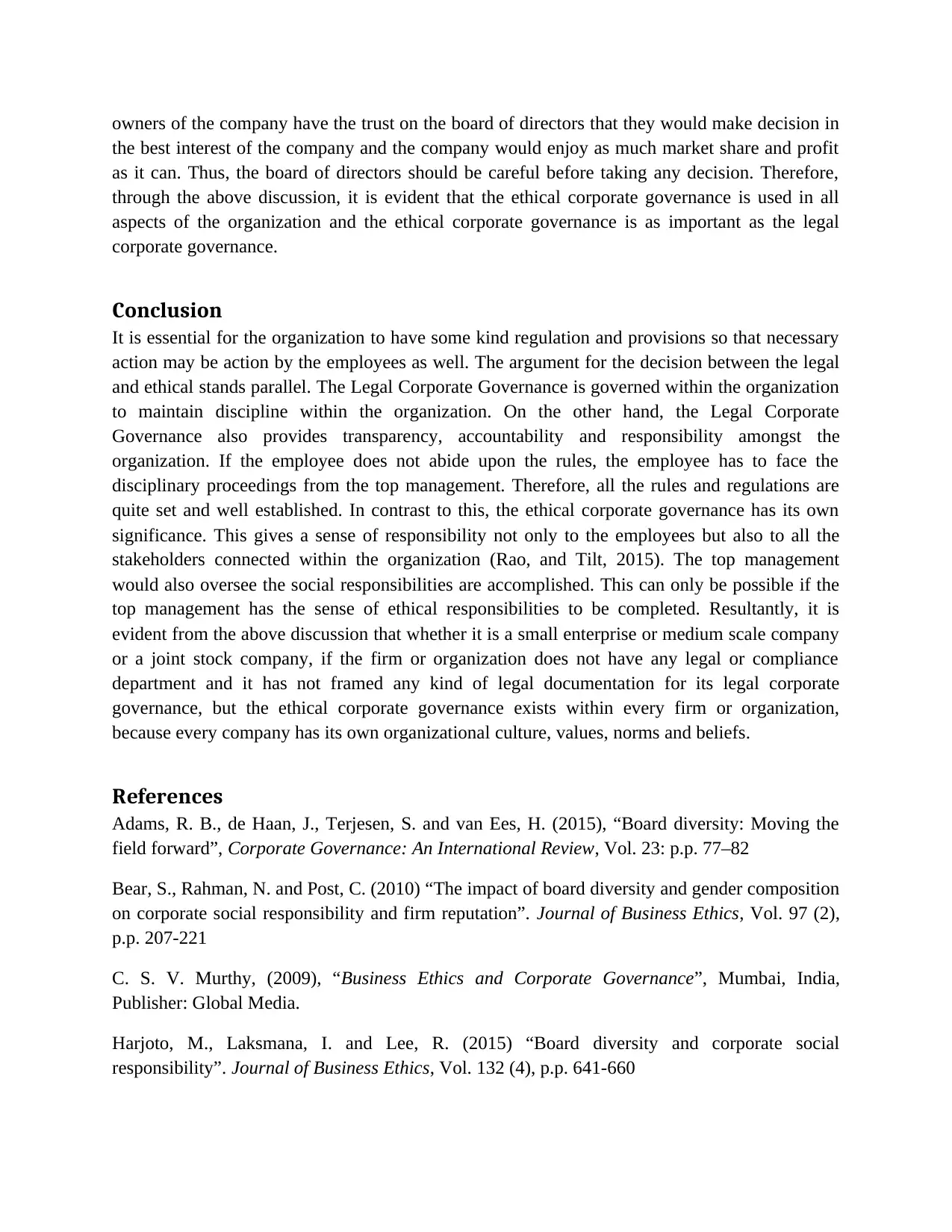
owners of the company have the trust on the board of directors that they would make decision in
the best interest of the company and the company would enjoy as much market share and profit
as it can. Thus, the board of directors should be careful before taking any decision. Therefore,
through the above discussion, it is evident that the ethical corporate governance is used in all
aspects of the organization and the ethical corporate governance is as important as the legal
corporate governance.
Conclusion
It is essential for the organization to have some kind regulation and provisions so that necessary
action may be action by the employees as well. The argument for the decision between the legal
and ethical stands parallel. The Legal Corporate Governance is governed within the organization
to maintain discipline within the organization. On the other hand, the Legal Corporate
Governance also provides transparency, accountability and responsibility amongst the
organization. If the employee does not abide upon the rules, the employee has to face the
disciplinary proceedings from the top management. Therefore, all the rules and regulations are
quite set and well established. In contrast to this, the ethical corporate governance has its own
significance. This gives a sense of responsibility not only to the employees but also to all the
stakeholders connected within the organization (Rao, and Tilt, 2015). The top management
would also oversee the social responsibilities are accomplished. This can only be possible if the
top management has the sense of ethical responsibilities to be completed. Resultantly, it is
evident from the above discussion that whether it is a small enterprise or medium scale company
or a joint stock company, if the firm or organization does not have any legal or compliance
department and it has not framed any kind of legal documentation for its legal corporate
governance, but the ethical corporate governance exists within every firm or organization,
because every company has its own organizational culture, values, norms and beliefs.
References
Adams, R. B., de Haan, J., Terjesen, S. and van Ees, H. (2015), “Board diversity: Moving the
field forward”, Corporate Governance: An International Review, Vol. 23: p.p. 77–82
Bear, S., Rahman, N. and Post, C. (2010) “The impact of board diversity and gender composition
on corporate social responsibility and firm reputation”. Journal of Business Ethics, Vol. 97 (2),
p.p. 207-221
C. S. V. Murthy, (2009), “Business Ethics and Corporate Governance”, Mumbai, India,
Publisher: Global Media.
Harjoto, M., Laksmana, I. and Lee, R. (2015) “Board diversity and corporate social
responsibility”. Journal of Business Ethics, Vol. 132 (4), p.p. 641-660
the best interest of the company and the company would enjoy as much market share and profit
as it can. Thus, the board of directors should be careful before taking any decision. Therefore,
through the above discussion, it is evident that the ethical corporate governance is used in all
aspects of the organization and the ethical corporate governance is as important as the legal
corporate governance.
Conclusion
It is essential for the organization to have some kind regulation and provisions so that necessary
action may be action by the employees as well. The argument for the decision between the legal
and ethical stands parallel. The Legal Corporate Governance is governed within the organization
to maintain discipline within the organization. On the other hand, the Legal Corporate
Governance also provides transparency, accountability and responsibility amongst the
organization. If the employee does not abide upon the rules, the employee has to face the
disciplinary proceedings from the top management. Therefore, all the rules and regulations are
quite set and well established. In contrast to this, the ethical corporate governance has its own
significance. This gives a sense of responsibility not only to the employees but also to all the
stakeholders connected within the organization (Rao, and Tilt, 2015). The top management
would also oversee the social responsibilities are accomplished. This can only be possible if the
top management has the sense of ethical responsibilities to be completed. Resultantly, it is
evident from the above discussion that whether it is a small enterprise or medium scale company
or a joint stock company, if the firm or organization does not have any legal or compliance
department and it has not framed any kind of legal documentation for its legal corporate
governance, but the ethical corporate governance exists within every firm or organization,
because every company has its own organizational culture, values, norms and beliefs.
References
Adams, R. B., de Haan, J., Terjesen, S. and van Ees, H. (2015), “Board diversity: Moving the
field forward”, Corporate Governance: An International Review, Vol. 23: p.p. 77–82
Bear, S., Rahman, N. and Post, C. (2010) “The impact of board diversity and gender composition
on corporate social responsibility and firm reputation”. Journal of Business Ethics, Vol. 97 (2),
p.p. 207-221
C. S. V. Murthy, (2009), “Business Ethics and Corporate Governance”, Mumbai, India,
Publisher: Global Media.
Harjoto, M., Laksmana, I. and Lee, R. (2015) “Board diversity and corporate social
responsibility”. Journal of Business Ethics, Vol. 132 (4), p.p. 641-660
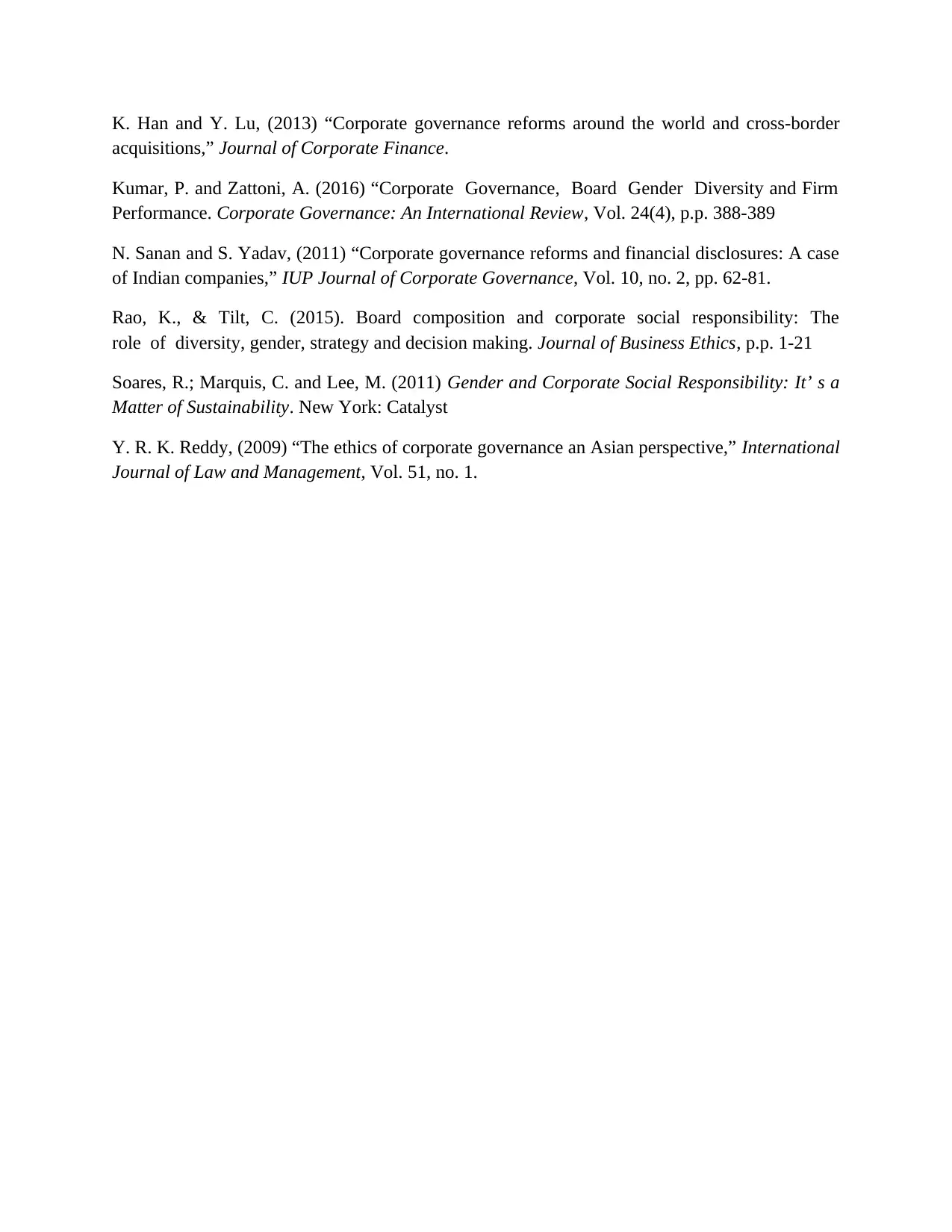
K. Han and Y. Lu, (2013) “Corporate governance reforms around the world and cross-border
acquisitions,” Journal of Corporate Finance.
Kumar, P. and Zattoni, A. (2016) “Corporate Governance, Board Gender Diversity and Firm
Performance. Corporate Governance: An International Review, Vol. 24(4), p.p. 388-389
N. Sanan and S. Yadav, (2011) “Corporate governance reforms and financial disclosures: A case
of Indian companies,” IUP Journal of Corporate Governance, Vol. 10, no. 2, pp. 62-81.
Rao, K., & Tilt, C. (2015). Board composition and corporate social responsibility: The
role of diversity, gender, strategy and decision making. Journal of Business Ethics, p.p. 1-21
Soares, R.; Marquis, C. and Lee, M. (2011) Gender and Corporate Social Responsibility: It’ s a
Matter of Sustainability. New York: Catalyst
Y. R. K. Reddy, (2009) “The ethics of corporate governance an Asian perspective,” International
Journal of Law and Management, Vol. 51, no. 1.
acquisitions,” Journal of Corporate Finance.
Kumar, P. and Zattoni, A. (2016) “Corporate Governance, Board Gender Diversity and Firm
Performance. Corporate Governance: An International Review, Vol. 24(4), p.p. 388-389
N. Sanan and S. Yadav, (2011) “Corporate governance reforms and financial disclosures: A case
of Indian companies,” IUP Journal of Corporate Governance, Vol. 10, no. 2, pp. 62-81.
Rao, K., & Tilt, C. (2015). Board composition and corporate social responsibility: The
role of diversity, gender, strategy and decision making. Journal of Business Ethics, p.p. 1-21
Soares, R.; Marquis, C. and Lee, M. (2011) Gender and Corporate Social Responsibility: It’ s a
Matter of Sustainability. New York: Catalyst
Y. R. K. Reddy, (2009) “The ethics of corporate governance an Asian perspective,” International
Journal of Law and Management, Vol. 51, no. 1.
⊘ This is a preview!⊘
Do you want full access?
Subscribe today to unlock all pages.

Trusted by 1+ million students worldwide
1 out of 6
Related Documents
Your All-in-One AI-Powered Toolkit for Academic Success.
+13062052269
info@desklib.com
Available 24*7 on WhatsApp / Email
![[object Object]](/_next/static/media/star-bottom.7253800d.svg)
Unlock your academic potential
Copyright © 2020–2025 A2Z Services. All Rights Reserved. Developed and managed by ZUCOL.




